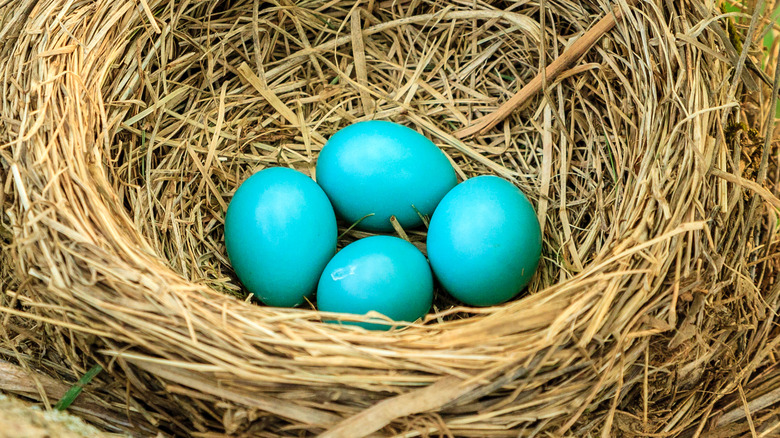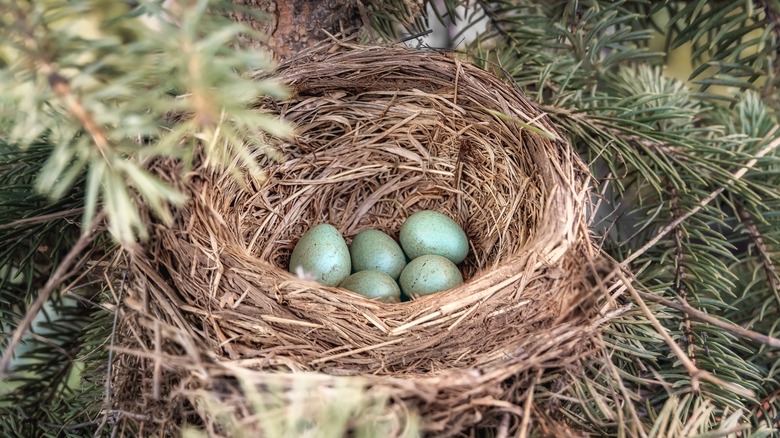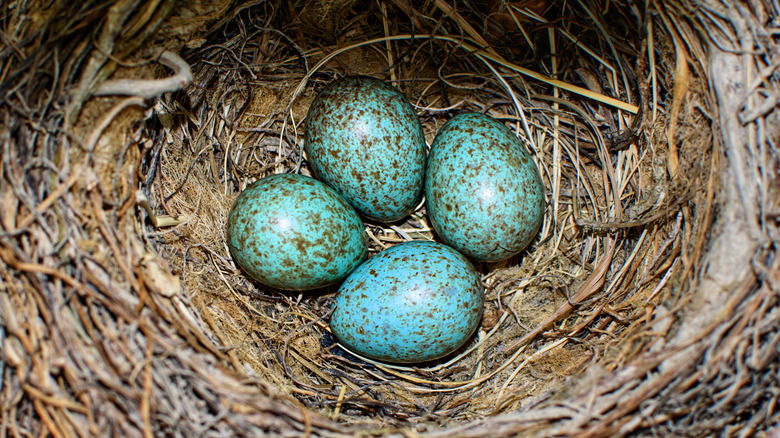The Reason Some Birds Lay Blue Eggs
As you may be aware, evolution is riddled with intricacies and mysteries that we're still unraveling ever since Charles Darwin published "On the Origin of Species" in 1859. There are still plenty of stunning discoveries to be found when we look at our fine feathered friends in the trees. If you've ever come across a bird's nest in the wild, you'll know that the eggs come in a range of hues and are extremely diverse in appearance. They frequently have specks, spots, and everything in between. However, one of the most curious varieties of bird eggs are those that are blue.
Many common bird species around the world have been observed laying blue eggs in the wild. Blue jays, robins, bluebirds, starlings, house finches, song thrushes, red-winged blackbirds, and magpies, for example, have all been documented laying blue eggs (per The Spruce). But what does this tell us about their behavior? Furthermore, how, if at all, do blue eggs help these birds carry on their genes to the next generation?
Science Behind Blue Eggs
Understanding the process by which birds make blue eggs is necessary before attempting to comprehend why they do so. Unlike mammals, birds don't have a uterus; instead, they use a structure called a cloaca to deposit their eggs (per The Spruce). The cloaca serves as a place for digestion and reproduction. Additionally, the chemical pigment biliverdin is present in the bile of several birds. These bird species produce biliverdin in the cloaca while they build the shells for their young (per Optics Mag). This compound is responsible for the blue hues in the eggs of certain bird species.
Many bird species are known to lay multiple eggs with each nest-building effort (per All About Birds). A larger concentration of biliverdin causes the first eggs to be deeper in color, whereas subsequent eggs may be lighter in hue or even include some colors of green (per World Animal Foundation). Now that we understand this, let's consider a couple of prominent theories that suggest why blue eggs have had a benefit to certain birds.
Possible Benefits
Bright blue bird eggs easily stand out in the nest. As a result, any potential predators are likely to see them as an easy lunch! Therefore, the idea that blue eggs provide camouflage protection in the nest is not as clear as it is for other bird species that lay muted brown eggs, such as chickens. The dominant idea concerning this blue coloration tends to point to eggs and the critical role that sunlight plays in their development. Birds frequently lay eggs in colors that correspond to their environments. Unhatched chicks are sensitive to the sun's heat and radiation, which can cause developmental delays or even death (per Optics Mag).
White or light-colored eggs are more commonly discovered in nests in warmer, more exposed areas, and as such, they have no trouble absorbing the sun's UV radiation (per World Animal Foundation). Darker eggs, however, stay cooler under the light, as too much radiation might be hazardous during incubation. Therefore, blue-colored eggs are sitting in an evolutionary sweet spot (per Forbes), essentially benefitting from the sun's rays, but not so much that it harms them.


